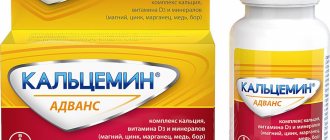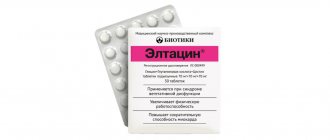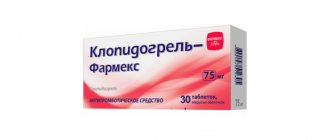Valocardine is available in various dosage forms, the most common drug being in the form of drops. Pharmaceutical companies also produce Valocardine in tablets, which are presented in the form of Doxylamine effervescent tablets. The drug is prescribed for the treatment of neurological diseases of various etiologies. However, taking the drug can cause side effects from many body systems, so treatment with tablet forms of the drug should be agreed with the attending physician.
Release form and composition
The drug is available in the form of white tablets, which, when dissolved in water, release gas bubbles.
One tablet contains:
- doxylamine succinate 15 mg;
- sodium bicarbonate;
- citric acid;
- sodium hydrogen phosphate;
- sodium sulfate;
- sodium benzoate;
- macrogoal
International trade name of the drug Valocordin-Doxylamine.
The drug is available in two types of tablets:
- effervescent (1 tablet dissolved in 100 ml of water);
- coated (taken orally with a minimum amount of liquid).
conclusions
Valocordin brings calm and has the ability to relieve vasospasm. The main active ingredients (phenobarbital and ethyl ester of bromoisovaleric acid) are toxic. However, when following the instructions, the risk of overdose is minimized.
There are such analogues of the drug Valocordin: Valordin, Valoserdin, Valoferin, Corvalol, Lavocordin, Pangluferal. In some of them, phenobarbital is replaced by diazepam.
Valocordin and its substitutes are poorly compatible with a good reaction, so they should not be taken by people in professions that require constant concentration (drivers).
Pharmacological properties
The active substance of the drug blocks ethanolamine receptors, due to which its sedative and hypnotic effects are revealed. The drug reduces the time it takes to fall asleep, which helps to increase the duration and quality of sleep. Taking the drug does not cause changes in sleep phases. Valocardin tablets also exhibit an antiallergic effect by blocking cholinergic receptors. The sedative effect of taking the medication is equal to the effect of using barbiturates. The therapeutic effect is observed for 6–8 hours.
Is the drug compatible with alcohol?
The metabolism of alcohol and Valocordin occurs in the liver. To neutralize these substances, the same biochemical reactions are used, which occur only in the presence of special proteins (enzymes). Hepatocytes inactivate foreign compounds, preventing their toxic effect on the body.
However, if the liver has to process two substances at the same time, its truss systems are unable to inactivate the entire volume at once. Therefore, the process is delayed, allowing the full spectrum of toxic effects of the drug and ethanol to manifest itself. This mechanism explains the impossibility of compatibility of hangover and phenobarbital in one organism at the same time.
Taking Valocordin against the background of alcoholism leads to side effects of this medication and increased hangover symptoms:
- signs of dysfunction of the gastrointestinal tract (constipation, diarrhea, malabsorption syndrome);
- allergic reactions;
- impaired concentration and reaction speed.
Indications for use
Tablet forms of the drug are used for the symptomatic treatment of conditions associated with sleep disorders.
The medication is widely used to treat conditions associated with disorders of the onset and maintenance of sleep.
The drug is prescribed for diseases:
- neuroses of various etiologies;
- mental disorders accompanied by sleep disorders;
- sleep disorder associated with time zone change or work schedule;
- asthenic syndrome;
- allergic manifestations;
- stressful conditions;
- itching of the skin.
Tablets are used for complex therapy of colds and coughs. In this situation, the drug helps to calm the nervous system, thus relaxing the patient so that he recovers faster.
Contraindications and side effects
In some cases, the use of Valocordin is contraindicated:
- individual intolerance to individual components;
- kidney disorders;
- liver disorders;
- all stages of pregnancy;
- feeding period;
- children up to 17 years old inclusive.
The drug can be used with caution in cases of diagnosed alcoholism, traumatic brain injury and other pathologies associated with the brain.
Side effects are rare, mainly due to long-term use. Main features:
- increased drowsiness;
- mild dizziness;
- decreased performance.
Due to constant violation of the dosage, symptoms of bromine poisoning may occur:
- depression, mood disorders;
- rhinitis;
- diathesis of hemorrhagic type;
- conjunctivitis;
- problems with coordination of movements;
- skin rashes and other allergic reactions.
If such symptoms occur, you should immediately stop taking it and consult a doctor. In case of bromine poisoning or allergic reactions, symptomatic treatment is indicated.
Mechanism of action
The active substance leads to inhibition of the activity of the nervous system, eliminates spasm of blood vessels, thus inducing sleep.
The tableted drug does not have a pronounced therapeutic effect, since it is not used in the treatment of diseases of the heart and blood vessels. The drug is intended to reduce negative symptoms of nervous disorders and improve the general condition of the patient.
The active components of the drug can lead to a decrease in blood pressure, so taking the drug is contraindicated for hypotensive patients. In some situations, specialists prescribe tablets for the complex treatment of arterial hypertension to gradually reduce blood pressure levels.
"Valocordin": composition, description
"Valocordin" is a drug containing 2 active ingredients;
- phenobarbital;
- ethyl bromoisovalerate.
Additional ingredients include water, ethyl alcohol, mint and hop oil. They give the product a characteristic smell.
Available in the form of drops that are taken orally. The bottle is glass, dark, the volume can be 20 or 50 ml. Has a sedative effect, reduces blood pressure. May have a slight hypnotic effect. The product is not produced in tablets.
The container can be stored at a standard temperature of no more than 25 and no less than 15 degrees Celsius. The place should be dark. Access for children is prohibited. The shelf life of the drug is 5 years.
The active components of Valocordin lead to a decrease in the intensity of excitation processes in the nervous system. Due to this, the person calms down, and sleep can come faster due to natural physiological reasons. In addition, the drug acts as an antispasmodic, counteracting sudden compression of blood vessels. Due to this, it slightly reduces blood pressure.
Dose selection
Effervescent tablets are prescribed to patients with sleep disorders, so the starting dose of the drug should be prescribed according to the instructions for use, or in the quantity selected by the treating doctor.
To determine the individual dose of medication and the duration of the therapeutic course, you need to contact a specialist
As a rule, a single dosage of the drug is from 15 to 25 mg per day. To treat allergic manifestations, the drug is taken at a dose of 25 mg every 4–6 hours. The maximum permissible daily dosage is 150 mg.
If the drug is prescribed to children aged 6 to 12 years, the dose is 6.25 and 12.5 mg, every 5-6 hours.
For patients with impaired functional ability of the excretory system or liver, as well as for elderly people, it is recommended to reduce the dose of the drug.
Instructions for use "Valocordin"
The drug is taken orally before meals, washed down with water. Single and daily dosage is established by the doctor depending on the gender, age, and condition of the patient. The instructions for the drug say that Valocordin should be taken 15-20 drops, with the maximum number of such doses being 3 times a day.
If the main goal of treatment is to eliminate sleep disorders, the dosage can be increased to 30 drops. Take it the night before bedtime. Simultaneous use with alcohol, caffeine and other psychostimulants is prohibited.
Reception features
After taking the pill, it is necessary to ensure a normal sleep duration, which is 7–8 hours, which will reduce the risk of a decrease in psychomotor reactions after waking up.
Effervescent tablets must first be dissolved in water
Rules that must be followed during the therapeutic course:
- Avoid sudden changes in body position, as this may cause slower reactions.
- During the course of treatment with Valocordin, it is not recommended to drink alcoholic beverages.
- Women during lactation while taking the medicine should stop breastfeeding and transfer the child to artificial feeding for the entire period of treatment.
- The drug reduces the reaction rate, so it is contraindicated to go outside and drive vehicles that require concentration.
- The tablets should be taken with a sufficient amount of liquid 60 minutes before going to bed.
Can Valocordin be used during pregnancy?
Phenobarbital, which is the main active ingredient of Valocordin, can have a toxic effect on the embryo. Therefore, the use of this drug in the first trimester is classified as contraindications.
During pregnancy, Valocordin can be used at a later stage, with the permission of a doctor. However, this can lead to blood clotting disorders in the baby and postpartum hemorrhage in the mother.
Therefore, if there are no indications, you should avoid taking this drug during pregnancy.
The simultaneous use of Valocordin and oral contraceptives weakens their effect. The consequence of this may be pregnancy. If a woman does not notice changes in her condition in time and continues to take the drug, this may negatively affect the health of her unborn child.
Side effects
If the dosage of the drug is not observed, the following disorders of organs and systems develop:
- Nervous system (headache, dizziness, drowsiness, seizures).
- Impaired function of the visual apparatus (increased intraocular pressure).
- Disturbances in the functioning of the circulatory system (rapid heartbeat, decreased blood pressure, hypertension, disturbances in the functioning of the heart).
- Respiratory dysfunction (bronchial obstruction, bronchospasm)
- Digestive tract (dry mouth, stool disorder in the form of constipation and diarrhea, pain in the stomach).
Selecting the dosage individually can reduce the risk of complications in older people.
Overdose: main symptoms
In case of overdose, increased drowsiness, dizziness, and decreased performance are observed. In case of severe overdose, more severe consequences may occur:
- pressure drop;
- coma;
- respiratory system disorder;
- vascular dysfunction;
- decreased manifestation of peripheral reflexes.
In this case, you should immediately seek medical help. Before the ambulance arrives, the patient must be laid down, ensuring complete rest. If possible, give several tablets of activated carbon and drink them with plenty of water.
Valocordin 20 ml drops for oral administration
Instructions for medical use of the drug VALOCORDIN® Trade name Valocordin® International nonproprietary name No Dosage form Drops for oral use, 20 ml and 50 ml Composition 100 g of solution contains active substances: phenobarbital - 2,000 g, ethyl bromoisovalerate - 2,000 g excipients: mint oil pepper, hop oil, ethanol 96% or 96.5%, purified water. 100 g contains 51 g of ethanol 96%. There are 20 drops in 1 ml. Description Transparent, colorless solution, with the odor of ethyl bromizovalerate and a pungent, bitter aromatic taste. Pharmacotherapeutic group: Hypnotics and sedatives. Sleeping pills and sedatives are different. ATC code N05CM Pharmacological properties Pharmacokinetics Barbiturate is resorbed already in the stomach. Approximately 35% of phenobarbital is bound to plasma albumin. The part not associated with albumin is filtered in the kidneys and, at low pH levels, is reabsorbed. Reverse diffusion does not occur due to the alkalinization of urine. The plasma half-life of phenobarbital is three days. 30% of phenobarbital is excreted unchanged in the urine, while a certain amount (a small amount) is oxidized in the liver. With prolonged use, phenobarbital accumulates in the plasma, as well as enzyme induction in the liver. This induction accelerates the breakdown of the barbiturate. Bromine bound in ethyl bromoisovalerate is excreted from the body very slowly. With prolonged use of the drug, it accumulates in the central nervous system, which leads to the development of bromism. Pharmacodynamics Valocordin® is a combination drug, the therapeutic effect of which is determined by the pharmacological properties of the components included in its composition. Phenobarbital has a sedative and vasodilating effect, and also has a mild hypnotic effect. Helps reduce excitation of the central nervous system and facilitates the onset of natural sleep. Ethyl bromizovalerate has sedative, hypnotic and antispasmodic effects. Peppermint oil has reflex vasodilator and antispasmodic activity. Indications for use - functional disorders of the cardiovascular system (including cardialgia, sinus tachycardia) - neuroses accompanied by irritability, anxiety, fear - insomnia (difficulty falling asleep) - states of excitation accompanied by pronounced vegetative reactions. Method of administration and dosage Valocordin® is taken orally, during meals, with a small amount of water. The dosage and duration of use of the drug is determined individually. Adults are usually prescribed 15-20 drops 3 times a day. If you have difficulty falling asleep, the dose can be increased to 30 drops. There is no experience of use for the treatment of children. Side effects Very rare (<1/10,000) - hypersensitivity reactions (shortness of breath, facial swelling, rash) - Stevens-Johnson syndrome (SJS) - toxic epidermal necrolysis (TEN) Uncommon (> 1/1,000 to <1 /100) - drowsiness, slight dizziness - pain in the stomach and intestines - allergic reactions Not known - reduction in bone mineral density, osteopenia, osteoporosis and fractures in patients who have taken phenobarbital for a long time - development of chronic bromine poisoning (with long-term use of large doses of the drug ), manifestations of which include: depressive mood, apathy, rhinitis, conjunctivitis, hemorrhagic diathesis, impaired coordination of movements. Contraindications: hypersensitivity to any of the components of the drug; severe renal and/or liver dysfunction; pregnancy, lactation; children and adolescents under 18 years of age. Drug interactions When Valocordin® is used simultaneously with sedatives, the sedative effect increases. Simultaneous use with neuroleptics and tranquilizers enhances, and with stimulants of the central nervous system, weakens the effect of each of the components of the drug. Alcohol enhances the effects of Valocordin® and may increase its toxicity. The presence of phenobarbital in Valocordin® can induce liver enzymes, and this makes its simultaneous use with drugs that are metabolized in the liver undesirable, since their concentration and, accordingly, effectiveness will decrease as a result of more accelerated metabolism (indirect anticoagulants, antibiotics, sulfonamides, etc. ) Pharmaceutical preparations containing valproic acid enhance the effect of barbiturates. In combination with coumarin derivatives, griseofulvin, glucocorticoids or oral contraceptives, due to the phenobarbital content in Valocordin®, an accelerated weakening of the effect of the above drugs may be observed as an undesirable interaction. Increases the toxicity of pharmaceutical preparations containing methotrexate. Special instructions With long-term use of the drug, the formation of drug dependence is possible; it is possible to accumulate bromine in the body and develop poisoning with it. Features of the effect of the drug on the ability to drive a vehicle or drive potentially dangerous mechanisms Valocordin®, even when used correctly, may weaken the ability to react quickly. This effect is enhanced by alcohol. In this regard, it is not recommended to drive a vehicle or work with potentially dangerous mechanisms during treatment. Overdose Symptoms: overdose is expressed by intoxication of varying severity. Symptoms of intoxication Acute (mild to moderate) barbiturate intoxication Dizziness, fatigue, even deep sleep from which the patient cannot be awakened. Acute severe intoxication Deep coma, accompanied by tissue hypoxia, shallow breathing, rapid at the beginning, later slowing down. Rapid heartbeat, cardiac arrhythmia, low blood pressure, vascular insufficiency, weak or absent reflexes. If intoxication is not treated, death may occur from circulatory failure, respiratory paralysis, or pulmonary edema. Long-term use of formulations containing bromine can lead to bromine poisoning, which is characterized by the following symptoms: confusion, ataxia, apathy, depressed mood, conjunctivitis, colds, acne or purpura Treatment of intoxication Cases of acute intoxication with Valocordin® should be treated with the same method as and intoxication with hypnotics and barbiturates, depending on the severity of intoxication symptoms. It is necessary to rinse the stomach and take activated charcoal. It is necessary to normalize breathing and blood circulation. Respiratory failure is overcome by artificial respiration, shock by infusion of plasma or substances added to increase plasma volume. If not much time has passed since taking the barbiturate, gastric lavage is prescribed (pour in a solution of two full tablespoons of activated carbon and sodium sulfate). In order to accelerate the removal of barbiturate from the body, forced alkalizing diuresis and hemodialysis and/or hemoperfusion are prescribed. Treatment of bromine poisoning: Large amounts of table salt with simultaneous intake of saluretics accelerate the removal of bromine ions from the body. Release form and packaging 20 ml and 50 ml of the drug are poured into brown glass bottles (hydrolytic class 3), with a vertical polyethylene dropper and a polypropylene screw cap. A self-adhesive label is placed on each bottle. 1 bottle, along with instructions for medical use in the state and Russian languages, is placed in a cardboard pack. Storage conditions Store at temperatures between 15 °C and 22 °C. Keep out of the reach of children! Shelf life: 5 years Do not use after expiration date! Conditions for dispensing from pharmacies Without a prescription Manufacturer Krevel Meuselbach GmbH Krevelstrasse 2 D-53783 Eitorf Germany Owner of the registration certificate Krevel Meuselbach GmbH, Germany Address of the organization accepting claims on the territory of the Republic of Kazakhstan from consumers regarding the quality of products (products) KFK Medservice Plus LLP, Republic Kazakhstan, 050004, Almaty, Mametova street, 54 Telephone/fax Email address








